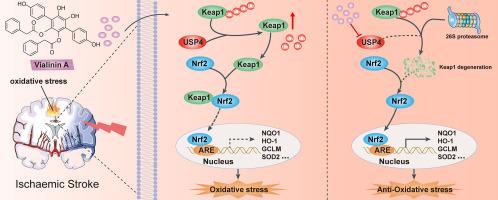Phytomedicine ( IF 6.7 ) Pub Date : 2023-12-19 , DOI: 10.1016/j.phymed.2023.155304 Meng Mao 1 , Qian Xia 2 , Gaofeng Zhan 2 , Hailong Bing 3 , Chenxi Zhang 3 , Jie Wang 3 , Wangli Tian 3 , Hongkai Lian 4 , Xing Li 2 , Qinjun Chu 3

|
Background
Oxidative stress is known as a hallmark of cerebral ischaemia‒reperfusion injury and it exacerbates the pathologic progression of ischaemic brain damage. Vialinin A, derived from a Chinese edible mushroom, possesses multiple pharmacological activities in cancer, Kawasaki disease, asthma and pathological scarring. Notably, vialinin A is an inhibitor of ubiquitin-specific peptidase 4 (USP4) that shows anti-inflammatory and antioxidative properties. However, the precise effect of vialinin A in ischaemic stroke, as well as its underlying mechanisms, remains largely unexplored.
Purpose
The present research focuses on the impacts of vialinin A on oxidative stress and explores the underlying mechanisms involved while also examining its potentiality as a therapeutic candidate for ischaemic stroke.
Methods
Mouse ischaemic stroke was conducted by MCAO surgery. Vialinin A was administered via lateral ventricular injection at a dose of 2 mg/kg after reperfusion. Subsequent experiments were meticulously conducted at the appropriate time points. Stroke outcomes were evaluated by TTC staining, neurological score, Nissl staining and behavioural analysis. Co-IP assays were operated to examine the protein-protein interactions. Immunoblot analysis, qRT-PCR, and luciferase reporter assays were conducted to further investigate its underlying mechanisms.
Results
In this study, we initially showed that administration of vialinin A alleviated cerebral ischaemia‒reperfusion injury-induced neurological deficits and neuronal apoptosis. Furthermore, vialinin A, which is an antioxidant, reduced oxidative stress injury, promoted the activation of the Keap1-Nrf2-ARE signaling pathway and increased the protein degradation of Keap1. The substantial neuroprotective effects of vialinin A against ischaemic stroke were compromised by the overexpression of USP4. Mechanistically, vialinin A inhibited the deubiquitinating enzymatic activity of USP4, leading to enhanced ubiquitination of Keap1 and subsequently promoting its degradation. This cascade caused the activation of Nrf2-dependent antioxidant response, culminating in a reduction of neuronal apoptosis and the amelioration of neurological dysfunction following ischaemic stroke.
Conclusions
This study demonstrates that inhibition of USP4 to activate Keap1-Nrf2-ARE signaling pathway may represent a mechanism by which vialinin A conferred protection against cerebral ischaemia‒reperfusion injury and sheds light on its promising prospects as a therapeutic intervention for ischaemic stroke.































 京公网安备 11010802027423号
京公网安备 11010802027423号